Water Retention Measures as a Remediation Technique for CSO-Affected Watercourses
Abstract
1. Introduction
- Water quality degradation—CSO discharges can severely degrade water quality in receiving waters, impacting aquatic life, human health, and drinking water sources;
- Eutrophication—high levels of nutrients (nitrogen and phosphorus) can lead to excessive plant growth (algae blooms) in water bodies, depleting oxygen levels, and harming aquatic life;
- Beach contamination—CSO discharges can contaminate beaches, leading to temporary closures and public health concerns, impacting tourism and recreational activities.
- Increase landscape resilience against the effects of climate;
- Improve water conditions in the river basin;
- Help retain water in the land during wet periods, and then make this water more available for ecosystems, agriculture, and forestry during drought periods;
- Preserve biodiversity of habitats that are strongly related to water resources, including habitats and species of great natural value.
2. Materials and Methods
2.1. Field Measurements
- pH indicates the acidity or alkalinity of water, which affects biological processes and the solubility of substances.
- Electrical conductivity reflects the concentration of dissolved ionic substances, often associated with anthropogenic pollution.
- Dissolved oxygen is essential for the survival of aquatic life and is a key indicator of aerobic or anaerobic conditions in the water body.
2.2. Design of the Numerical Model
- Establish the purpose of the model, which determines the use of appropriate mathematical equations and appropriate software for solving the given task. As already mentioned, HEC-RAS software was selected for the design of the 1D numerical model of the Trnávka River. HEC-RAS offers several advantages, one of which is free availability. Others are user-friendly interface and data management, and more importantly, its integration with GIS. Equations used in HEC-RAS are described in [33];
- Develop a conceptual model of the system based on all available data in order to obtain the natural conditions of the studied area. During this phase, the geodetic survey of the Trnávka River was conducted, as already described above;
- Model design—the conceptual model is adjusted into a form suitable for modeling. Boundary conditions are set, and preliminary values for calibration parameters are selected;
- Calibration with the purpose of establishing that the model can reproduce field-measured data—data measured during the second stage of the field measurements. Calibration of the Trnávka numerical model was conducted by trial-and-error adjustment of the calibration parameter, which was the value of Manning’s roughness coefficient (presented in Table 1).
- Prediction—response of the system to future events. The model is run with calibrated values, except for those that are expected to change in the future – construction of three inflatable rubber weirs (Figure 4).
3. Results
3.1. Numerical Modeling
- The first one was proposed for the profile at a relative km 2.754, locality Štrky (Figure 4a)—the profile of the previously removed sluice gate (Figure 2), where it is possible to use the already existing substructure. The height of the weir is 1.0 m, which corresponds to the height of the removed sluice gate;
- The second (Weir Calvary) was designed at the relative km 1.433 near a park (Figure 4b) where a panel access road descends, allowing easy access for construction equipment to the construction site and later for maintenance (as it was their original purpose). This lower structure will create a backwater level directly in the city and thus complete the park environment with a more prominent water element. The maximum height was designed at 0.6 m;
- The third weir can be located near the Monument to the Victims of World War I at a relative km 0.0005 (Figure 4c). Its maximum height was designed to be 0.75 m. The structure would make the adjacent park area more attractive, and together with the previously mentioned two weirs, it can create a cascade of hydraulic structures on the Trnávka River.
3.2. The Results of the Chemical–Physical Measurement Campaign
4. Discussion
5. Conclusions
Author Contributions
Funding
Institutional Review Board Statement
Informed Consent Statement
Data Availability Statement
Acknowledgments
Conflicts of Interest
References
- US Environmental Protection Agency. Combined Sewer Overflow Basics. Available online: https://www.epa.gov/npdes/combined-sewer-overflow-basics (accessed on 8 January 2025).
- Butler, D.; Digman, C.; Makropoulos, C.; Davies, J.W. Urban Drainage, 5th ed.; CRC Press: Boca Raton, FL, USA, 2024; ISBN 978-1-003-40863-5. [Google Scholar]
- Combined Sewer Overflows Explained. Available online: https://environmentagency.blog.gov.uk/2020/07/02/combined-sewer-overflows-explained/ (accessed on 8 January 2025).
- Botturi, A.; Ozbayram, E.G.; Tondera, K.; Gilbert, N.I.; Rouault, P.; Caradot, N.; Gutierrez, O.; Daneshgar, S.; Frison, N.; Akyol, Ç.; et al. Combined Sewer Overflows: A Critical Review on Best Practice and Innovative Solutions to Mitigate Impacts on Environment and Human Health. Crit. Rev. Environ. Sci. Technol. 2021, 51, 1585–1618. [Google Scholar] [CrossRef]
- Reyes-Silva, J.; Bangura, E.; Helm, B.; Benisch, J.; Krebs, P. The Role of Sewer Network Structure on the Occurrence and Magnitude of Combined Sewer Overflows (CSOs). Water 2020, 12, 2675. [Google Scholar] [CrossRef]
- Jung, Y.E.; Jeong, M.M.; Jun, H.; Smith, T. Contemplation of Improvement Efforts to Manage Combined Sewer Overflows. Infrastructures 2023, 8, 150. [Google Scholar] [CrossRef]
- Sokáč, M.; Bara, M.K.; Velísková, Y.; Sočuvka, V. Rainfall Data in Urban Drainage: What Do We Need? Acta Hydrol. Slovaca 2025, 26, 132–143. [Google Scholar]
- Muttil, N.; Nasrin, T.; Sharma, A.K. Impacts of Extreme Rainfalls on Sewer Overflows and WSUD-Based Mitigation Strategies: A Review. Water 2023, 15, 429. [Google Scholar] [CrossRef]
- US EPA. R. 01 Soak Up the Rain: The Benefits of Green Infrastructure. Available online: https://www.epa.gov/soakuptherain/soak-rain-benefits-green-infrastructure (accessed on 16 January 2025).
- Fletcher, T.D.; Shuster, W.; Hunt, W.F.; Ashley, R.; Butler, D.; Arthur, S.; Trowsdale, S.; Barraud, S.; Semadeni-Davies, A.; Bertrand-Krajewski, J.-L.; et al. SUDS, LID, BMPs, WSUD and More—The Evolution and Application of Terminology Surrounding Urban Drainage. Urban Water J. 2015, 12, 525–542. [Google Scholar] [CrossRef]
- Eckart, K.; McPhee, Z.; Bolisetti, T. Performance and Implementation of Low Impact Development—A Review. Sci. Total Environ. 2017, 607–608, 413–432. [Google Scholar] [CrossRef]
- Riechel, M.; Matzinger, A.; Pallasch, M.; Joswig, K.; Pawlowsky-Reusing, E.; Hinkelmann, R.; Rouault, P. Sustainable Urban Drainage Systems in Established City Developments: Modelling the Potential for CSO Reduction and River Impact Mitigation. J. Environ. Manag. 2020, 274, 111207. [Google Scholar] [CrossRef]
- Hoban, A. Water Sensitive Urban Design Approaches and Their Description. In Approaches to Water Sensitive Urban Design; Elsevier: Amsterdam, The Netherlands, 2019; pp. 25–47. ISBN 978-0-12-812843-5. [Google Scholar]
- Mustafa, M.; Zhou, J.; Alyaseri, I. Effect of Rainfall Intensity on Stormwater Reduction in Combined Sewers from the Impact of Permeable Pavements. In Proceedings of the World Environmental and Water Resources Congress, Sacramento, CA, USA, 21–25 May 2017; American Society of Civil Engineers: Sacramento, CA, USA, 2017; pp. 383–390. [Google Scholar]
- Llopart-Mascaró, A.; Farreny, R.; Gabarrell, X.; Rieradevall, J.; Gil, A.; Martínez, M.; Puertas, J.; Suárez, J.; Río, H.D.; Paraira, M. Storm Tank against Combined Sewer Overflow: Operation Strategies to Minimise Discharges Impact to Receiving Waters. Urban Water J. 2015, 12, 219–228. [Google Scholar] [CrossRef]
- Martino, G.D.; De Paola, F.; Fontana, N.; Marini, G.; Ranucci, A. Pollution Reduction in Receivers: Storm-Water Tanks. J. Urban Plan. Dev. 2011, 137, 29–38. [Google Scholar] [CrossRef]
- Azurix North America; Stirrup, M.; Marchant, D. New City of Hamilton, Water Quality. Simulation of a Combined Sewer Overflow Storage Tank. J. Water Manag. Model. 2002, 10, 271–287. [Google Scholar] [CrossRef]
- Casal-Campos, A.; Fu, G.; Butler, D.; Moore, A. An Integrated Environmental Assessment of Green and Gray Infrastructure Strategies for Robust Decision Making. Environ. Sci. Technol. 2015, 49, 8307–8314. [Google Scholar] [CrossRef] [PubMed]
- Casal-Campos, A.; Sadr, S.M.K.; Fu, G.; Butler, D. Reliable, Resilient and Sustainable Urban Drainage Systems: An Analysis of Robustness under Deep Uncertainty. Environ. Sci. Technol. 2018, 52, 9008–9021. [Google Scholar] [CrossRef] [PubMed]
- Sokáč, M.; Velísková, Y.; Koczka Bara, M. Effect Evaluation of Different Adaptation Measures Applied on Urban Catchment. In Proceedings of the Symposium Proceedings, Štrbské Pleso, Slovakia, 10 September 2024; Spektrum STU Publishing: Štrbské Pleso, Slovakia, 2024; pp. 453–461. [Google Scholar]
- Rizzo, A.; Tondera, K.; Pálfy, T.G.; Dittmer, U.; Meyer, D.; Schreiber, C.; Zacharias, N.; Ruppelt, J.P.; Esser, D.; Molle, P.; et al. Constructed Wetlands for Combined Sewer Overflow Treatment: A State-of-the-Art Review. Sci. Total Environ. 2020, 727, 138618. [Google Scholar] [CrossRef] [PubMed]
- Tao, W.; Bays, J.; Meyer, D.; Smardon, R.; Levy, Z. Constructed Wetlands for Treatment of Combined Sewer Overflow in the US: A Review of Design Challenges and Application Status. Water 2014, 6, 3362–3385. [Google Scholar] [CrossRef]
- Masi, F.; Rizzo, A.; Bresciani, R.; Conte, G. Constructed Wetlands for Combined Sewer Overflow Treatment: Ecosystem Services at Gorla Maggiore, Italy. Ecol. Eng. 2017, 98, 427–438. [Google Scholar] [CrossRef]
- Palermo, M.; Hays, D.F. Sediment Dredging, Treatment and Disposal. In Processes, Assessment and Remediation of Contaminated Sediments; Reible, D.D., Ed.; SERDP/ESTCP Environmental Remediation Technology; Springer: New York, NY, USA, 2014; Volume 6, pp. 365–391. ISBN 978-1-4614-6725-0. [Google Scholar]
- Portnov, M.; Hrudka, J.; Wittmanová, R.; Ilavská, J.; Stanko, Š. Monitoring the Quality of Overflowed Waters in Slovakia. Pollack Period. 2024. published online ahead of print. [Google Scholar] [CrossRef]
- Naz, A.; Chowdhury, A.; Mishra, B.K. Applications of Microbes in Bioremediation of Point Source Pollutants from Wastewater. IOP Conf. Ser. Earth Environ. Sci. 2021, 796, 012039. [Google Scholar] [CrossRef]
- Shah, N.; Marulanda, D.; DeLorenzo, R.; De Rugeris, J.; Staniec, T. CSO Sediment Removal in an Urban Tributary. In Proceedings of the Western Dredging Association (WEDA XXXII) Technical Conference and Texas A&M University (TAMU 43) Dredging Seminar, San Antonio, TX, USA, 10 June 2012. [Google Scholar]
- Yan, J.; Li, F. Effects of Sediment Dredging on Freshwater System: A Comprehensive Review. Environ. Sci. Pollut. Res. 2023, 30, 119612–119626. [Google Scholar] [CrossRef]
- European Commission. Directorate General for the Environment. EU Policy Document on Natural Water Retention Measures: By the Drafting Team of the WFD CIS Working Group Programme of Measures (WG PoM); Publications Office: Luxembourg, 2014. [Google Scholar]
- Zeleňáková, M.; Diaconu, D.C.; Haarstad, K. Urban Water Retention Measures. Procedia Eng. 2017, 190, 419–426. [Google Scholar] [CrossRef]
- Spatial Plan of the City of Trnava; EKOPOLIS—Ateliér Architektúry, Urbanizmu a Územného Plánovania: Bratislava, Slovakia, 2010; p. 233. (In Slovak)
- Hegyi, L.; Miterková, I.; Schvalb, M.; Šteiner, A. Trnava Adaptation Strategy on the Impacts of Climate Change—Waves of Heat; KRI: Košice, Slovakia, 2015; p. 104. [Google Scholar]
- Brunner, G.W. HEC-RAS River Analysis System. Hydraulic Reference Manual. Version 5.0; US Army Corps of Engineers, Hydrologic Engineering Center (HEC): Davis, CA, USA, 2016. [Google Scholar]
- Marsh-McBirney, Inc. FLO-MATE. Model 2000 Portable Flowmeter Instruction Manual; Marsh-McBirney, Inc.: Frederick, MD, USA, 1990. [Google Scholar]
- SVP. OZ Piešťany, TBD Department. Handling Regulations of Boleráz Hydraulic Structure (Reservoir on the Trnávka River in rkm 27,350); SVP: Piešťany, Slovakia, 2006. (In Slovak) [Google Scholar]
- Květon, R.; Orfánus, M. Hydroinformatics 1st Part. Simulation of Surface Water Flow Processes in Open Channels and Through Hydraulic Structures; Slovak University of Technology in Bratislava: Bratislava, Slovakia, 2015; ISBN 978-80-227-4468-3. (In Slovak) [Google Scholar]
- Šulek, P. Weirs; Spektrum STU Publishing: Bratislava, Slovakia, 2023; ISBN 978-80-227-5381-4. (In Slovak) [Google Scholar]
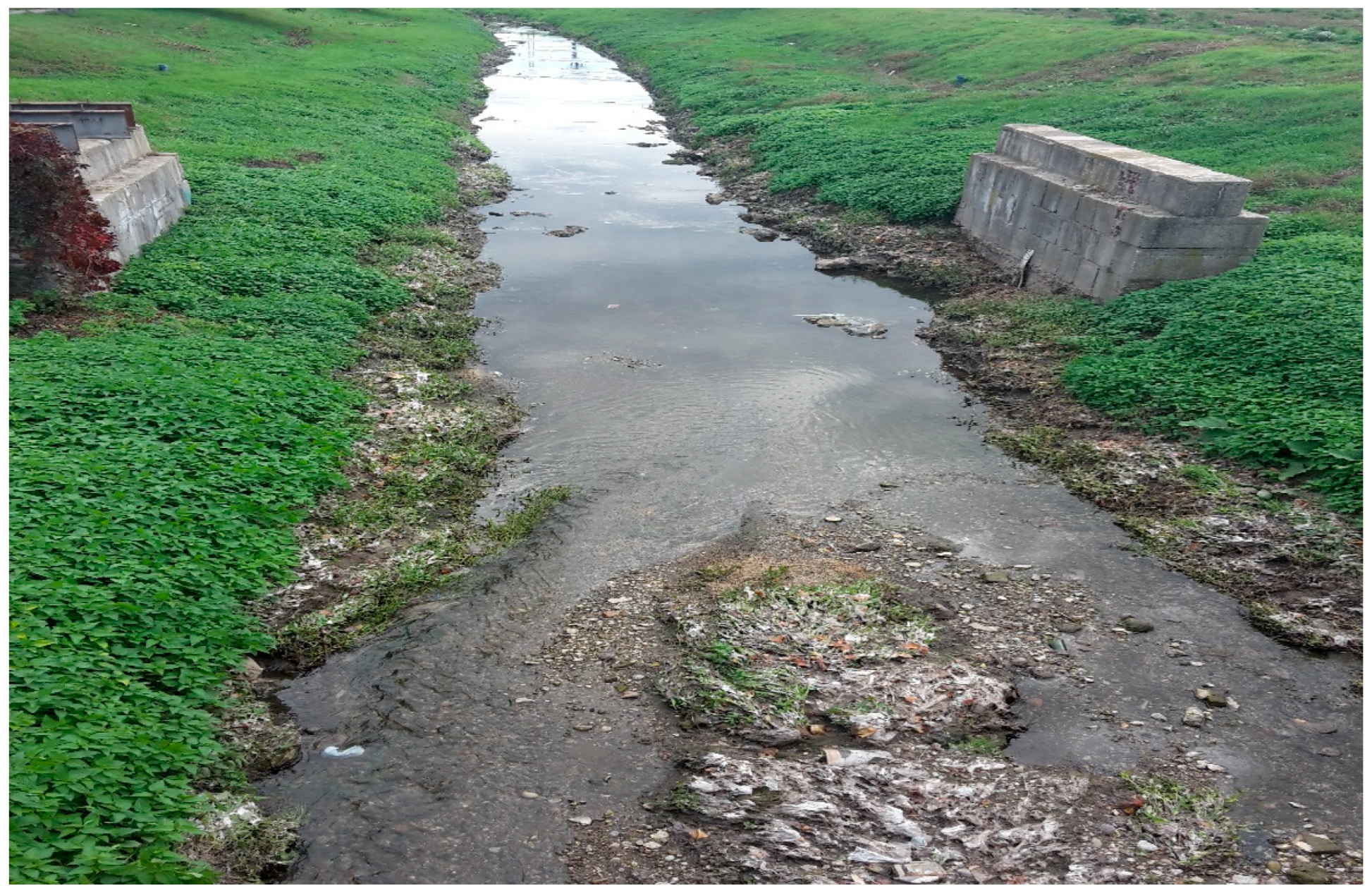
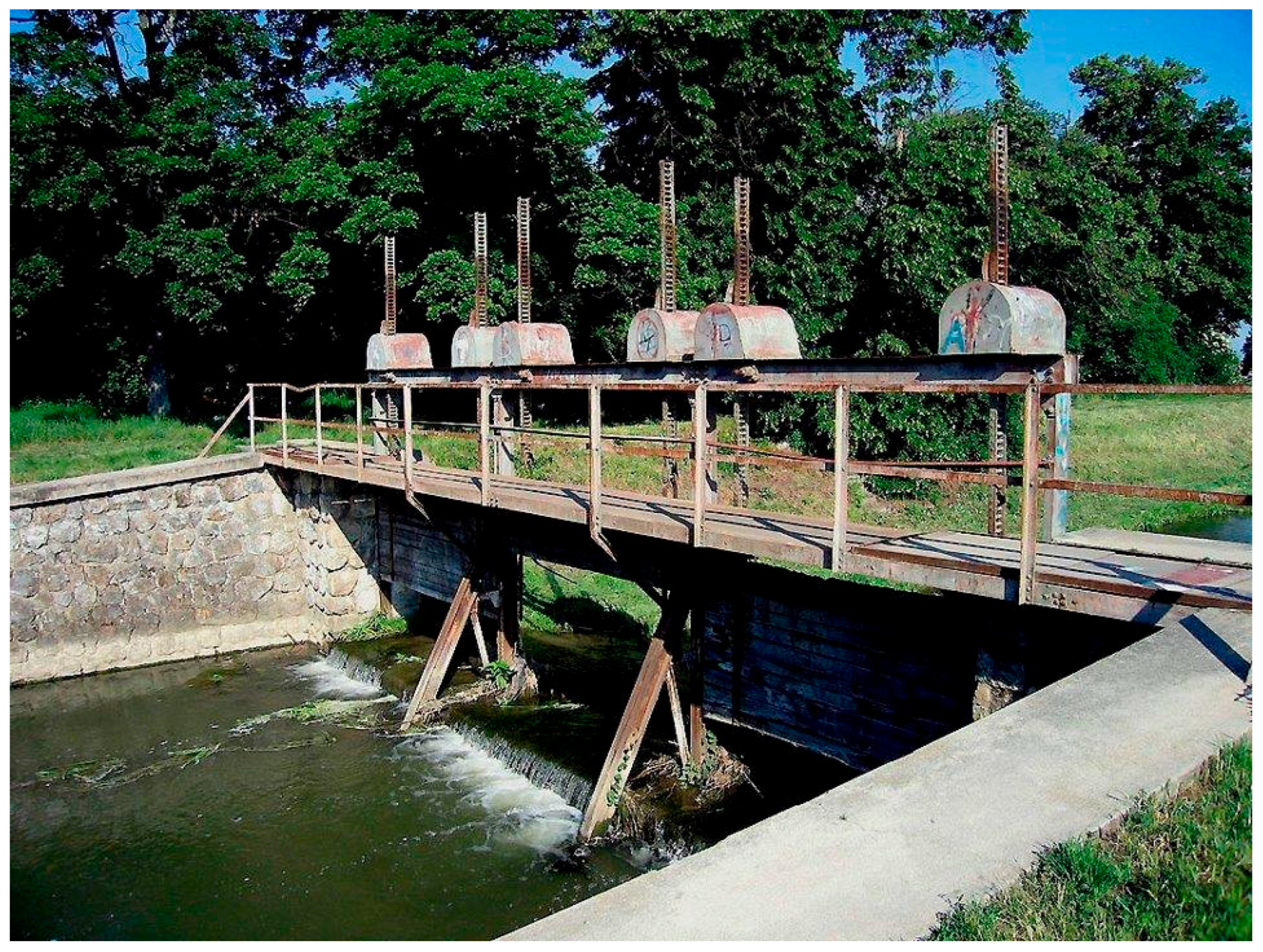
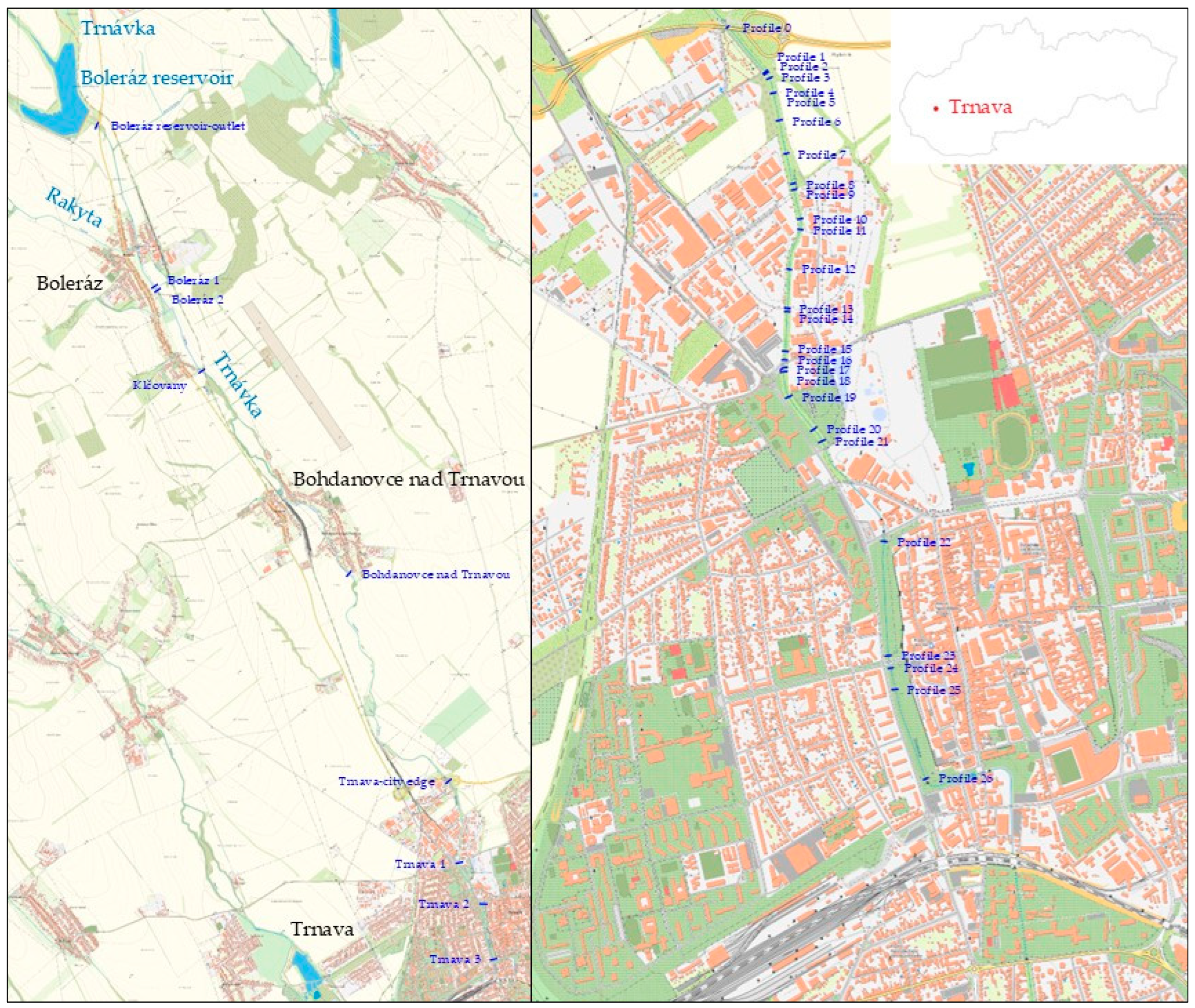

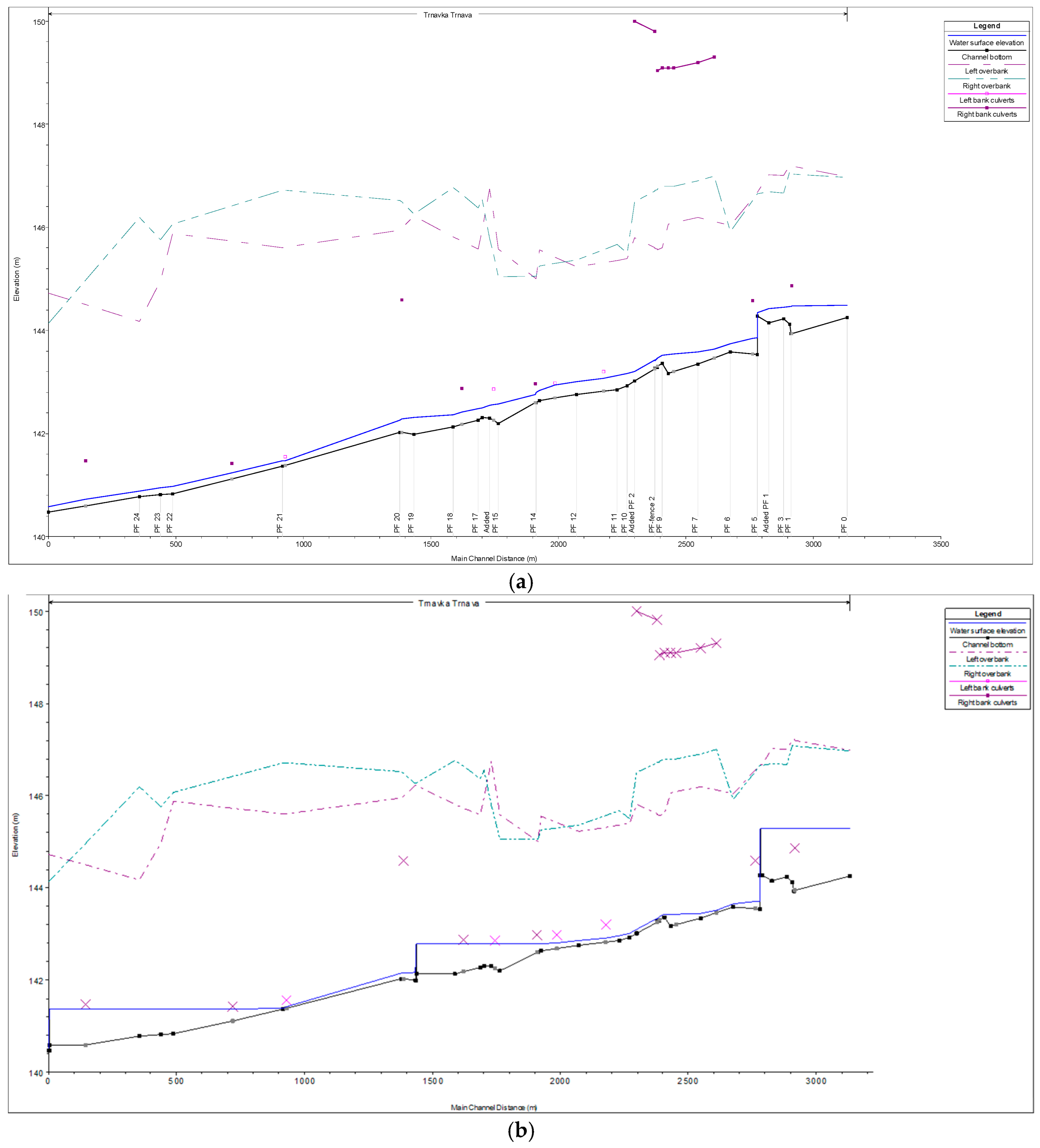
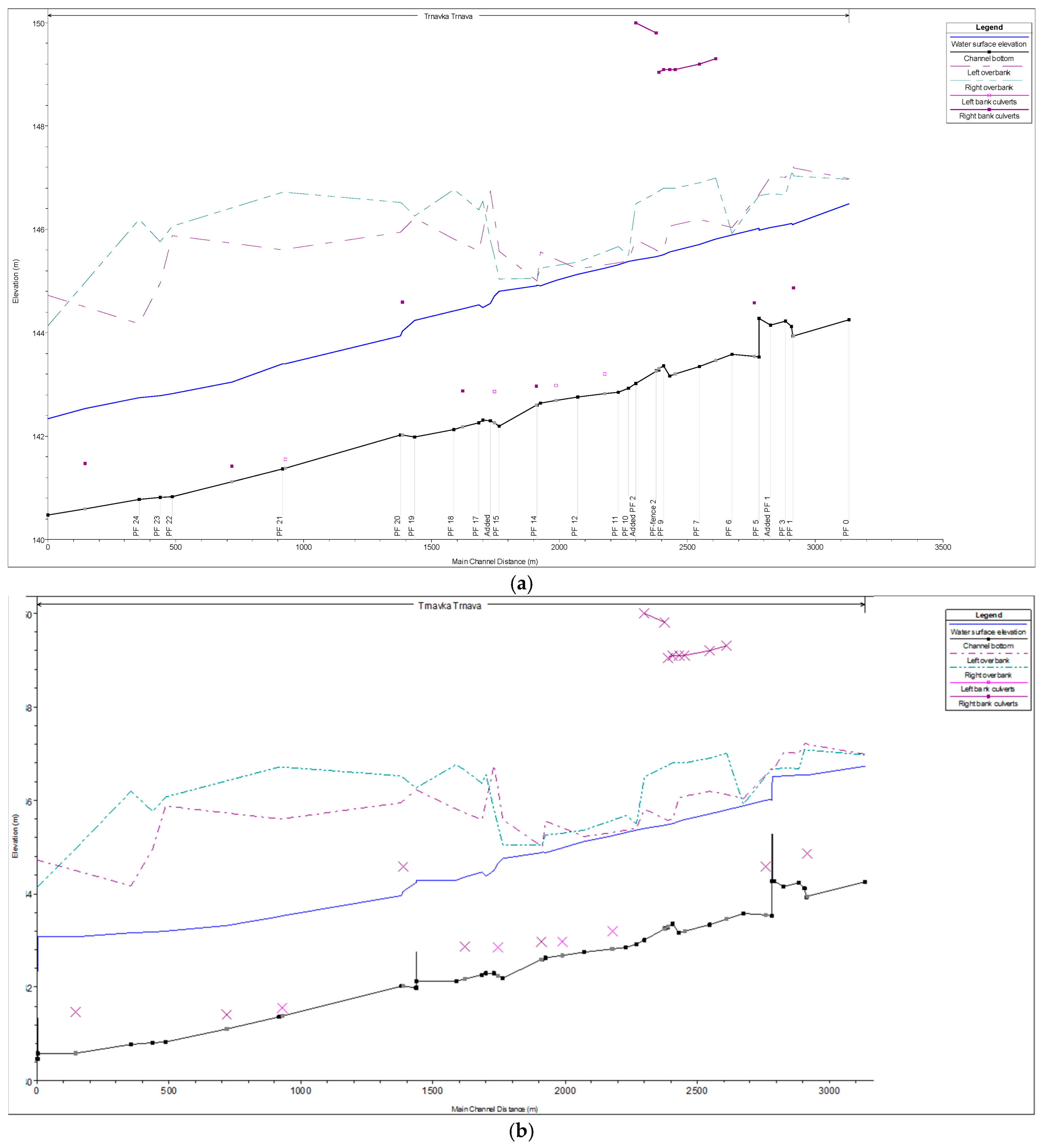
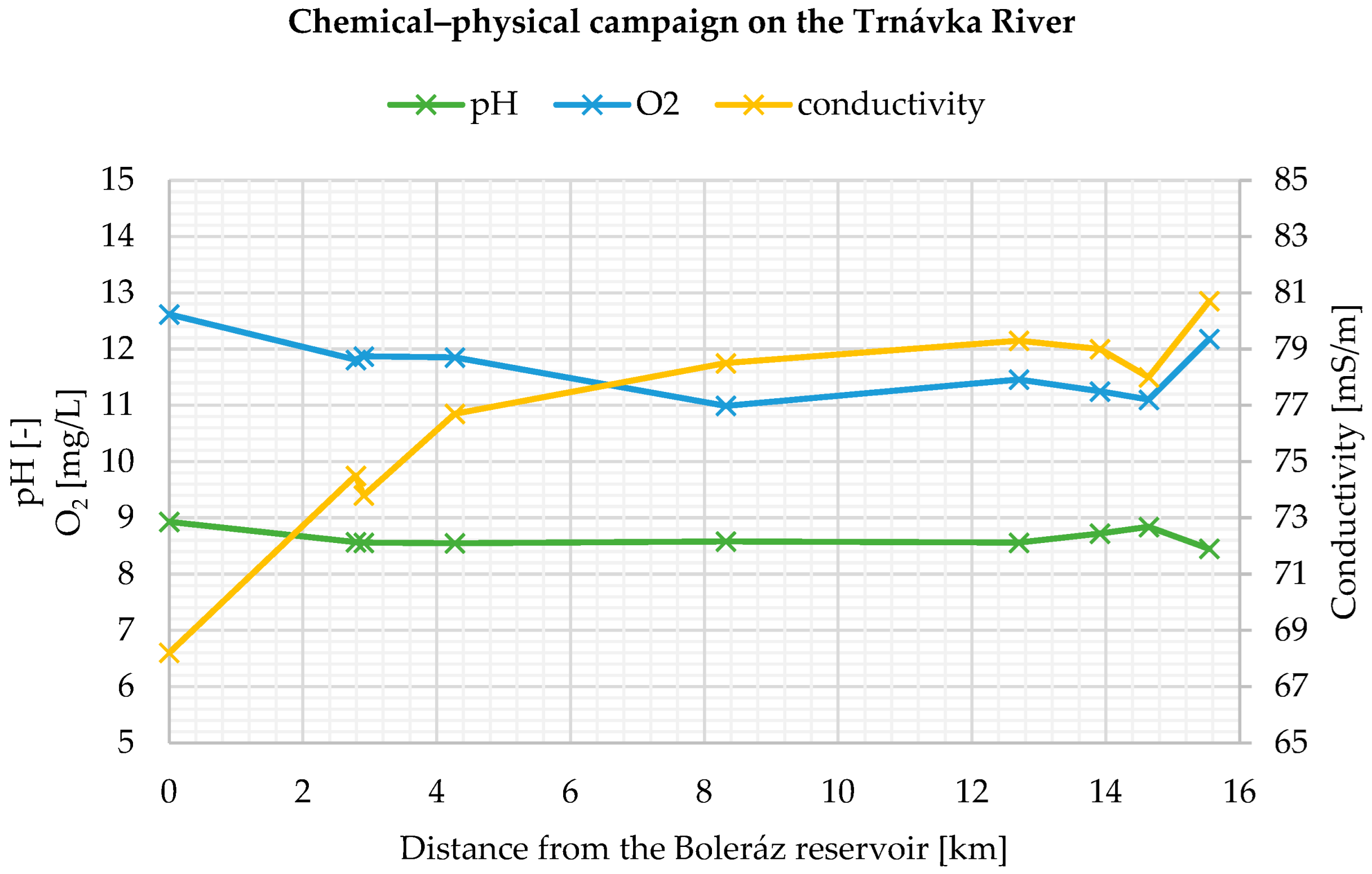
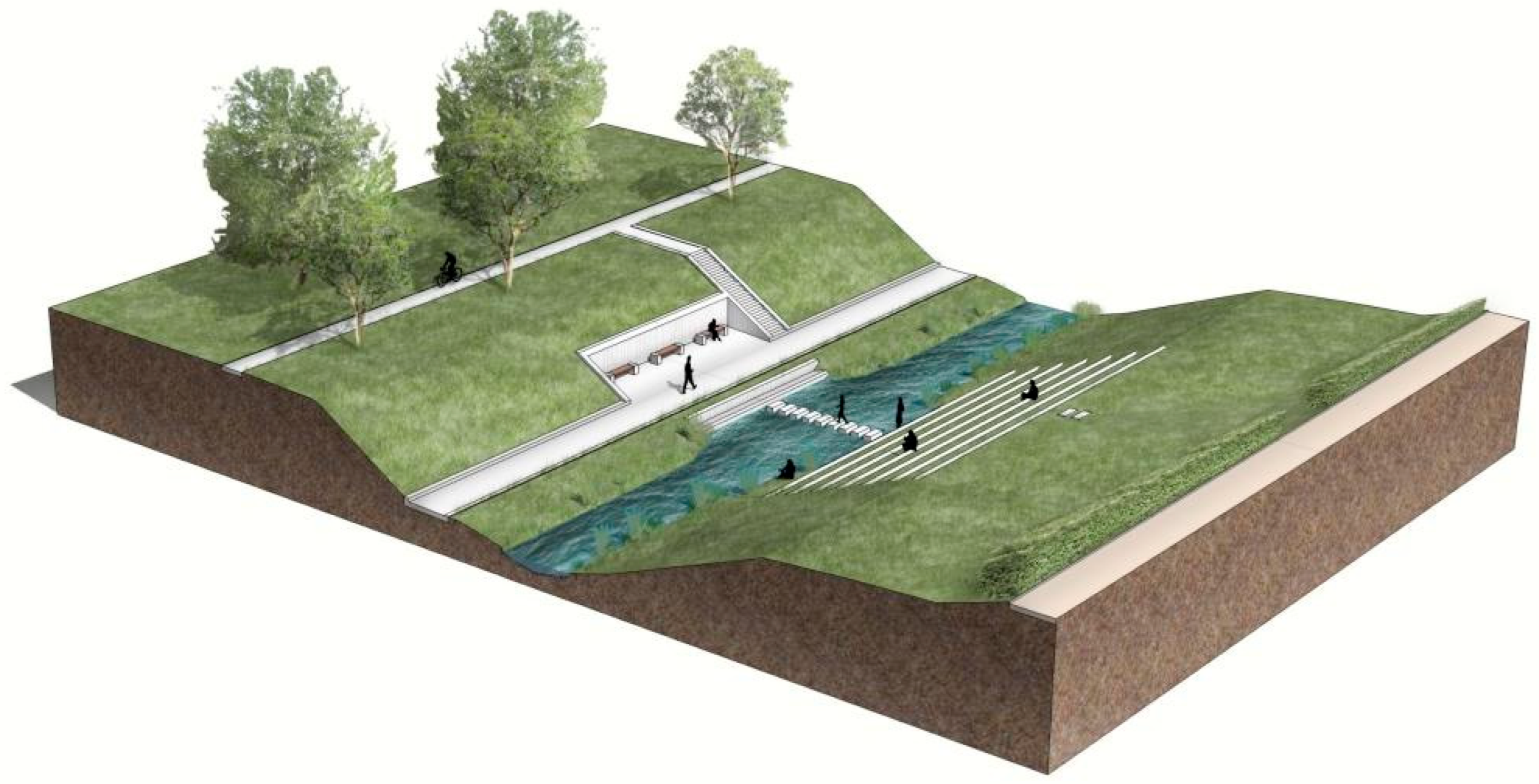
| Manning’s Roughness Coefficient | ||
|---|---|---|
| Relative km | River Bottom | Riverbank |
| 0.000–1.379 1 | 0.010 (concrete blocks) | 0.020 (concrete blocks) |
| 1.379 1–3.062 | 0.020 (stone fortification) | 0.030 (short grass) |
| Locality | pH | Conductivity σ [mS/m] | Dissolved Oxygen O2 [mg/L] |
|---|---|---|---|
| Boleráz reservoir—outlet | 8.93 | 68.2 | 12.62 |
| Boleráz 1 | 8.57 | 74.5 | 11.81 |
| Boleráz 2 | 8.56 | 73.8 | 11.87 |
| Klčovany | 8.55 | 76.7 | 11.85 |
| Bohdanovce and Trnavou | 8.58 | 78.5 | 10.99 |
| Trnava—city edge | 8.56 | 79.3 | 11.46 |
| Trnava 1 | 8.72 | 79.0 | 11.25 |
| Trnava 2 | 8.84 | 78.0 | 11.10 |
| Trnava 3 | 8.45 | 80.7 | 12.18 |
Disclaimer/Publisher’s Note: The statements, opinions and data contained in all publications are solely those of the individual author(s) and contributor(s) and not of MDPI and/or the editor(s). MDPI and/or the editor(s) disclaim responsibility for any injury to people or property resulting from any ideas, methods, instructions or products referred to in the content. |
© 2025 by the authors. Licensee MDPI, Basel, Switzerland. This article is an open access article distributed under the terms and conditions of the Creative Commons Attribution (CC BY) license (https://creativecommons.org/licenses/by/4.0/).
Share and Cite
Červeňanská, M.; Mydla, J.; Šoltész, A.; Orfánus, M.; Šulek, P.; Hrudka, J.; Wittmanová, R.; Honti, R. Water Retention Measures as a Remediation Technique for CSO-Affected Watercourses. Sustainability 2025, 17, 6280. https://doi.org/10.3390/su17146280
Červeňanská M, Mydla J, Šoltész A, Orfánus M, Šulek P, Hrudka J, Wittmanová R, Honti R. Water Retention Measures as a Remediation Technique for CSO-Affected Watercourses. Sustainability. 2025; 17(14):6280. https://doi.org/10.3390/su17146280
Chicago/Turabian StyleČerveňanská, Michaela, Jakub Mydla, Andrej Šoltész, Martin Orfánus, Peter Šulek, Jaroslav Hrudka, Réka Wittmanová, and Richard Honti. 2025. "Water Retention Measures as a Remediation Technique for CSO-Affected Watercourses" Sustainability 17, no. 14: 6280. https://doi.org/10.3390/su17146280
APA StyleČerveňanská, M., Mydla, J., Šoltész, A., Orfánus, M., Šulek, P., Hrudka, J., Wittmanová, R., & Honti, R. (2025). Water Retention Measures as a Remediation Technique for CSO-Affected Watercourses. Sustainability, 17(14), 6280. https://doi.org/10.3390/su17146280











